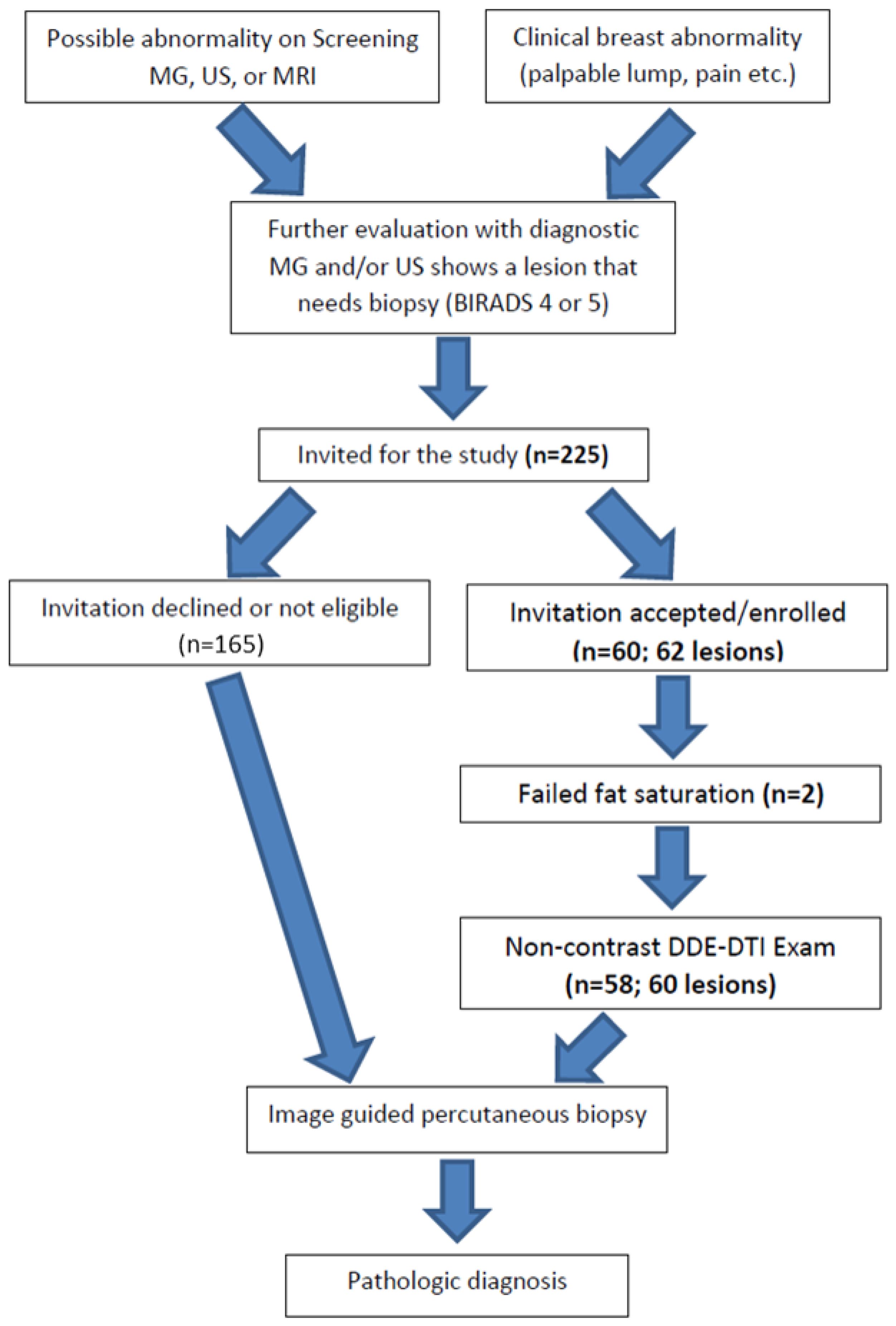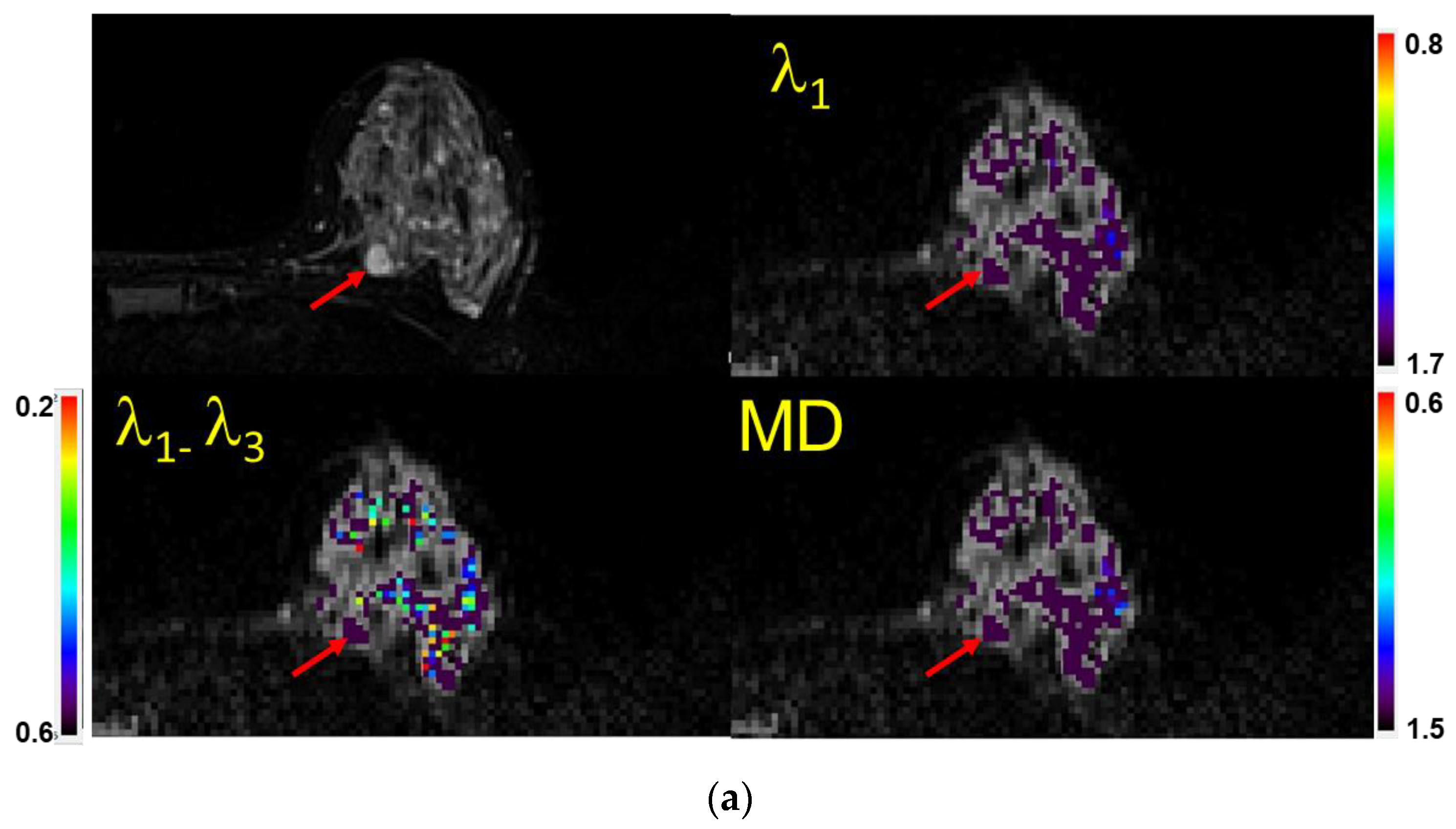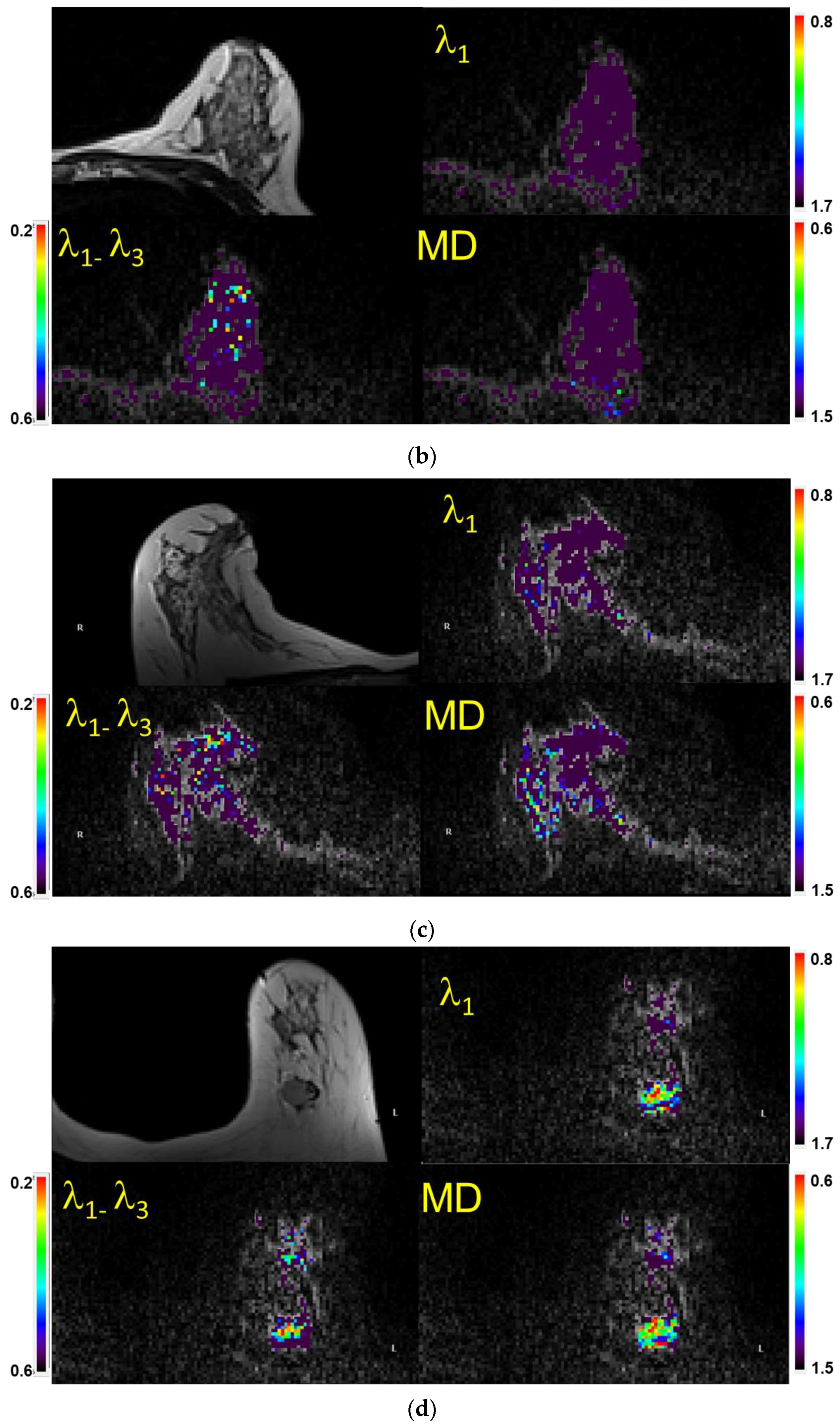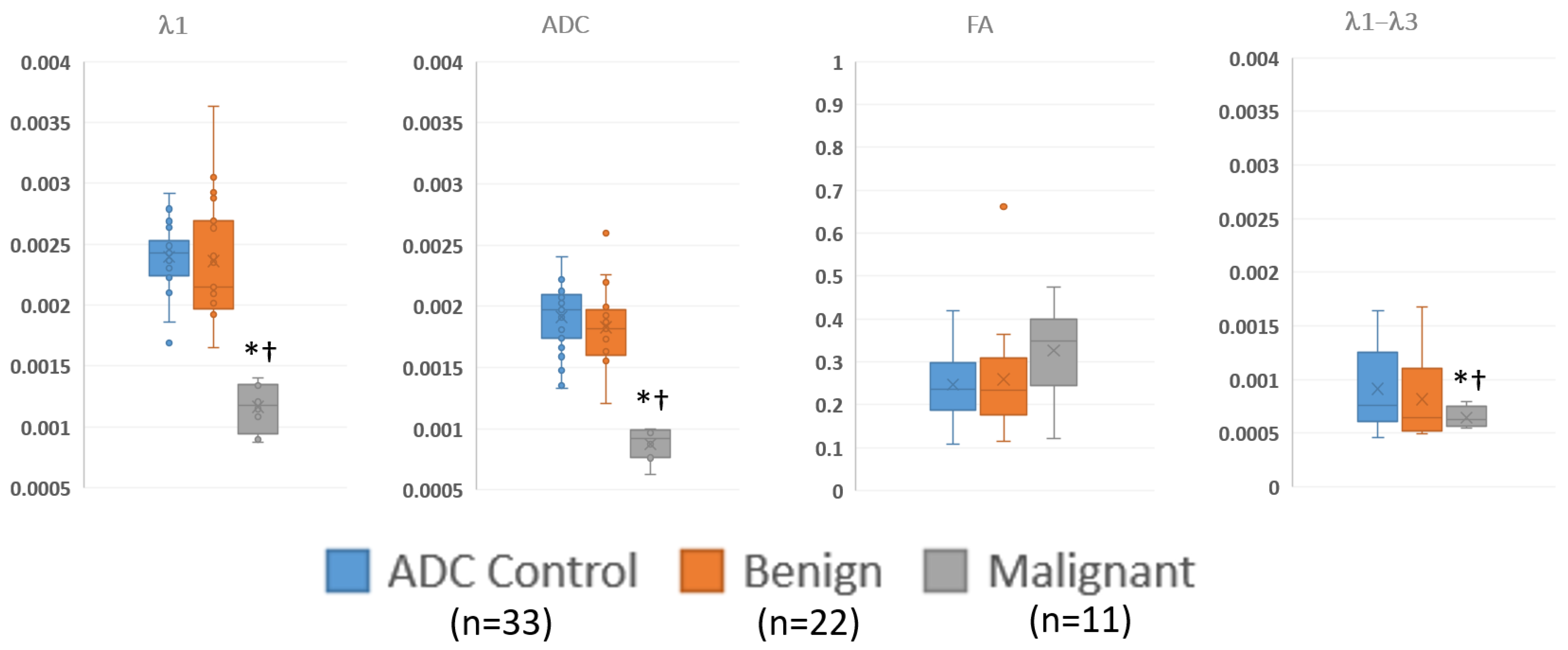Feasibility of Diffusion Tensor Imaging for Decreasing Biopsy Rates in Breast Imaging: Interim Analysis of a Prospective Study
Abstract
1. Introduction
2. Materials and Methods
2.1. Subjects and Study Design
2.2. MRI Acquisition
2.3. Image Processing
2.4. Data Analysis
2.5. Statistical Analysis
3. Results
3.1. Semi-Quantitative Evaluation of the DTI Scans
3.2. Quantitative Evaluation of the Visible Lesions
4. Discussion
5. Conclusions
Author Contributions
Funding
Institutional Review Board Statement
Informed Consent Statement
Data Availability Statement
Acknowledgments
Conflicts of Interest
References
- Galati, F.; Moffa, G.; Pediconi, F. Breast imaging: Beyond the detection. Eur. J. Radiol. 2022, 146, 110051. [Google Scholar] [CrossRef] [PubMed]
- Kuhl, C.K.; Strobel, K.; Bieling, H.; Leutner, C.; Schild, H.H.; Schrading, S. Supplemental Breast MR Imaging Screening of Women with Average Risk of Breast Cancer. Radiology 2017, 283, 361–370. [Google Scholar] [CrossRef] [PubMed]
- Niell, B.L.; Freer, P.E.; Weinfurtner, R.J.; Arleo, E.K.; Drukteinis, J.S. Screening for Breast Cancer. Radiol. Clin. N. Am. 2017, 55, 1145–1162. [Google Scholar] [CrossRef] [PubMed]
- Qaseem, A.; Lin, J.S.; Mustafa, R.A.; Horwitch, C.A.; Wilt, T.J.; Clinical Guidelines Committee of the American College of Physicians. Screening for Breast Cancer in Average-Risk Women: A Guidance Statement from the American College of Physicians. Ann. Intern. Med. 2019, 170, 547–560. [Google Scholar] [CrossRef] [PubMed]
- Lehman, C.D.; Arao, R.F.; Sprague, B.L.; Lee, J.M.; Buist, D.S.; Kerlikowske, K.; Henderson, L.M.; Onega, T.; Tosteson, A.N.; Rauscher, G.H.; et al. National Performance Benchmarks for Modern Screening Digital Mammography: Update from the Breast Cancer Surveillance Consortium. Radiology 2017, 283, 49–58. [Google Scholar] [CrossRef] [PubMed]
- Amornsiripanitch, N.; Bickelhaupt, S.; Shin, H.J.; Dang, M.; Rahbar, H.; Pinker, K.; Partridge, S.C. Diffusion-weighted MRI for Unenhanced Breast Cancer Screening. Radiology 2019, 293, 504–520. [Google Scholar] [CrossRef]
- Johnson, J.M.; Johnson, A.K.; O’Meara, E.S.; Miglioretti, D.L.; Geller, B.M.; Hotaling, E.N.; Herschorn, S.D. Breast cancer detection with short-interval follow-up compared with return to annual screening in patients with benign stereotactic or US-guided breast biopsy results. Radiology 2015, 275, 54–60. [Google Scholar] [CrossRef]
- Vlahiotis, A.; Griffin, B.; Stavros, A.T.; Margolis, J. Analysis of utilization patterns and associated costs of the breast imaging and diagnostic procedures after screening mammography. Clin. Outcomes Res. 2018, 10, 157–167. [Google Scholar] [CrossRef]
- Maimone, S.; Harper, L.K.; Mantia, S.K.; Advani, P.P.; Hochwald, A.P.; Li, Z.; Hines, S.L.; Patel, B. MRI phenotypes associated with breast cancer predisposing genetic variants, a multisite review. Eur. J. Radiol. 2023, 162, 110788. [Google Scholar] [CrossRef]
- Clauser, P.; Krug, B.; Bickel, H.; Dietzel, M.; Pinker, K.; Neuhaus, V.F.; Marino, M.A.; Moschetta, M.; Troiano, N.; Helbich, T.H.; et al. Diffusion-weighted Imaging Allows for Downgrading MR BI-RADS 4 Lesions in Contrast-enhanced MRI of the Breast to Avoid Unnecessary Biopsy. Clin. Cancer Res. 2021, 27, 1941–1948. [Google Scholar] [CrossRef]
- Pinkney, D.M.; Chikarmane, S.A.; Giess, C.S. Do benign-concordant breast MRI biopsy results require short interval follow-up imaging? Report of longitudinal study and review of the literature. Clin. Imaging 2019, 57, 50–55. [Google Scholar] [CrossRef]
- Spiegel, T.N.; Esplen, M.J.; Hill, K.A.; Wong, J.; Causer, P.A.; Warner, E. Psychological impact of recall on women with BRCA mutations undergoing MRI surveillance. Breast 2011, 20, 424–430. [Google Scholar] [CrossRef]
- Baltzer, A.; Dietzel, M.; Kaiser, C.G.; Baltzer, P.A. Combined reading of Contrast Enhanced and Diffusion Weighted Magnetic Resonance Imaging by using a simple sum score. Eur. Radiol. 2016, 26, 884–891. [Google Scholar] [CrossRef]
- Baltzer, P.; Mann, R.M.; Iima, M.; Sigmund, E.E.; Clauser, P.; Gilbert, F.J.; Martincich, L.; Partridge, S.C.; Patterson, A.; Pinker, K.; et al. Diffusion-weighted imaging of the breast-a consensus and mission statement from the EUSOBI International Breast Diffusion-Weighted Imaging working group. Eur. Radiol. 2020, 30, 1436–1450. [Google Scholar] [CrossRef]
- Rahbar, H.; Zhang, Z.; Chenevert, T.L.; Romanoff, J.; Kitsch, A.E.; Hanna, L.G.; Harvey, S.M.; Moy, L.; DeMartini, W.B.; Dogan, B.; et al. Utility of Diffusion-weighted Imaging to Decrease Unnecessary Biopsies Prompted by Breast MRI: A Trial of the ECOG-ACRIN Cancer Research Group (A6702). Clin. Cancer Res. 2019, 25, 1756–1765. [Google Scholar] [CrossRef]
- Le Bihan, D.; Mangin, J.F.; Poupon, C.; Clark, C.A.; Pappata, S.; Molko, N.; Chabriat, H. Diffusion tensor imaging: Concepts and applications. J. Magn. Reson. Imaging 2001, 13, 534–546. [Google Scholar] [CrossRef]
- Eyal, E.; Shapiro-Feinberg, M.; Furman-Haran, E.; Grobgeld, D.; Golan, T.; Itzchak, Y.; Catane, R.; Papa, M.; Degani, H. Parametric diffusion tensor imaging of the breast. Investig. Radiol. 2012, 47, 284–291. [Google Scholar] [CrossRef]
- Shapiro-Feinberg, M.; Weisenberg, N.; Zehavi, T.; Furman-Haran, E.; Grobgeld, D.; Nissan, N.; Degani, H. Clinical results of DTI. Eur. J. Radiol. 2012, 81 (Suppl. 1), S151–S152. [Google Scholar] [CrossRef]
- Furman-Haran, E.; Grobgeld, D.; Nissan, N.; Shapiro-Feinberg, M.; Degani, H. Can diffusion tensor anisotropy indices assist in breast cancer detection? J. Magn. Reson. Imaging 2016, 44, 1624–1632. [Google Scholar] [CrossRef]
- Nissan, N.; Furman-Haran, E.; Feinberg-Shapiro, M.; Grobgeld, D.; Eyal, E.; Zehavi, T.; Degani, H. Tracking the mammary architectural features and detecting breast cancer with magnetic resonance diffusion tensor imaging. J. Vis. Exp. 2014, 94, e52048. [Google Scholar] [CrossRef]
- Scaranelo, A.M.; Degani, H.; Grobgeld, D.; Talbot, N.; Bodolai, K.; Furman-Haran, E. Effect of IV Administration of a Gadolinium-Based Contrast Agent on Breast Diffusion-Tensor Imaging. AJR Am. J. Roentgenol. 2020, 215, 1030–1036. [Google Scholar] [CrossRef]
- Baxter, G.C.; Graves, M.J.; Gilbert, F.J.; Patterson, A.J. A Meta-analysis of the Diagnostic Performance of Diffusion MRI for Breast Lesion Characterization. Radiology 2019, 291, 632–641. [Google Scholar] [CrossRef] [PubMed]
- Wang, K.; Li, Z.; Wu, Z.; Zheng, Y.; Zeng, S.E.L.; Liang, J. Diagnostic Performance of Diffusion Tensor Imaging for Characterizing Breast Tumors: A Comprehensive Meta-Analysis. Front Oncol. 2019, 9, 1229. [Google Scholar] [CrossRef] [PubMed]
- Iima, M.; Partridge, S.C.; Le Bihan, D. Six DWI questions you always wanted to know but were afraid to ask: Clinical relevance for breast diffusion MRI. Eur. Radiol. 2020, 30, 2561–2570. [Google Scholar] [CrossRef]
- Thomassin-Naggara, I.; Tardivon, A.; Chopier, J. Standardized diagnosis and reporting of breast cancer. Diagn. Interv. Imaging 2014, 95, 759–766. [Google Scholar] [CrossRef] [PubMed]
- Berger, N.; Varga, Z.; Frauenfelder, T.; Boss, A. MRI-guided breast vacuum biopsy: Localization of the lesion without contrast-agent application using diffusion-weighted imaging. Magn. Reson. Imaging 2017, 38, 1–5. [Google Scholar] [CrossRef]
- Montemezzi, S.; Cardano, G.; Storer, S.; Cardobi, N.; Cavedon, C.; Camera, L. MRI-guided breast biopsy based on diffusion-weighted imaging: A feasibility study. Eur. Radiol. 2021, 31, 2645–2656. [Google Scholar] [CrossRef]
- Jeong, S.; Kim, T.H. Diffusion-weighted imaging of breast invasive lobular carcinoma: Comparison with invasive carcinoma of no special type using a histogram analysis. Quant. Imaging Med. Surg. 2022, 12, 95–105. [Google Scholar] [CrossRef]
- Pinker, K.; Moy, L.; Sutton, E.J.; Mann, R.M.; Weber, M.; Thakur, S.B.; Jochelson, M.S.; Bago-Horvath, Z.; Morris, E.A.; Baltzer, P.A.; et al. Diffusion-Weighted Imaging with Apparent Diffusion Coefficient Mapping for Breast Cancer Detection as a Stand-Alone Parameter: Comparison with Dynamic Contrast-Enhanced and Multiparametric Magnetic Resonance Imaging. Investig. Radiol. 2018, 53, 587–595. [Google Scholar] [CrossRef]
- McKay, J.A.; Church, A.L.; Rubin, N.; Emory, T.H.; Hoven, N.F.; Kuehn-Hajder, J.E.; Nelson, M.T.; Ramanna, S.; Auerbach, E.J.; Moeller, S.; et al. A Comparison of Methods for High-Spatial-Resolution Diffusion-weighted Imaging in Breast MRI. Radiology 2020, 297, 304–312. [Google Scholar] [CrossRef]
- Otikovs, M.; Nissan, N.; Furman-Haran, E.; Anaby, D.; Allweis, T.M.; Agassi, R.; Sklair-Levy, M.; Frydman, L. Diffusivity in breast malignancies analyzed for b > 1000 s/mm2 at 1 mm in-plane resolutions: Insight from Gaussian and non-Gaussian behaviors. J. Magn. Reson. Imaging 2021, 53, 1913–1925. [Google Scholar] [CrossRef]





| Participants Consented (n = 62) | ||
| Age | ||
| 50.9 ± 13.6 | n | % |
| Breast density (n = 62) | ||
| Unknown | 4 | 6.5 |
| (A) Fatty | 1 | 1.6 |
| (B) Scattered fibroglandular tissue | 12 | 19.4 |
| (C) Heterogeneously dense | 38 | 61.3 |
| (D) Extremely dense | 7 | 11.3 |
| BI-RADS (n = 62) | ||
| 3 | 7 | 11.7 |
| 4 | 47 | 73.3 |
| 5 | 8 | 13.3 |
| Original Presentation (n = 62) | ||
| Mammogram | 41 | 66.1 |
| ABUS | 11 | 17.7 |
| MRI | 4 | 6.5 |
| Palpable | 6 | 9.7 |
| Histopathology (n = 61) | ||
| Benign | 47 | 77.0 |
| Malignant | 14 | 23.0 |
| Lesion size (cm) | ||
| <1.0 | 17 | 27.9 |
| 1–1.9 | 30 | 49.2 |
| ≥2.0 | 8 | 13.1 |
| Not apparent | 6 | 9.8 |
| Lesions biopsied per patient (n = 61) | ||
| 1 | 57 | 96.6 |
| 2 | 2 | 3.4 |
| Cancer Type (n = 14) | ||
| IDC | 8 | 57.2 |
| ILC | 1 | 7.1 |
| DCIS | 2 | 14.3 |
| Mixed | 3 | 21.4 |
| Benign subtype (n = 47) | ||
| Normal breast tissue | 7 | 14.9 |
| Benign intramammary node | 1 | 2.1 |
| Fibroadenoma | 18 | 38.3 |
| Fat necrosis | 2 | 4.3 |
| Fibrocystic changes (FCD) * | 9 | 19.1 |
| PASH | 6 | 12.8 |
| Radial Scar/CSL | 2 | 4.3 |
| ALH | 2 | 4.3 |
| ADH | 1 | 2.1 |
| Parameter | T2-wtd TSE | Fat-Sat T2 | DTI |
|---|---|---|---|
| Sequence | Turbo SE | Turbo IR Magnitude | Single Shot SE-EPI |
| Field of View | 400 × 350 mm | 370 × 403 mm | 400 × 350 mm |
| Slice Thickness | 2 mm | 2 mm | 2 mm |
| Repetition Time | 2400 ms | 5320 ms | 9100 ms |
| Echo Time | 83 ms | 82 ms | 90 ms |
| Inversion Time | n/a | 220 ms | n/a |
| B value | n/a | n/a | 0, 700 s/mm2 |
| No. of Diffusion directions | n/a | n/a | 30 |
| Average | 2 | 2 | 1 |
| GRAPPA | 2 | 2 | 2 |
| Flip angle | 120° | 120° | 90° |
| Matrix | 256 × 192 | 320 × 278° | 192 × 144 |
| # of Slices | 60 | 60 | 60 |
| Turbo factor | 9 | 10 | n/a |
| Bandwidth | 219 Hz/pixel | 244 Hz/pixel | 1370 Hz/pixel |
| Slice Interval | 2 mm | 2 mm | 2 mm |
| Feature | Interpretation | Recommendation |
|---|---|---|
| Lesion visible (2) and all purple. | Definitely benign (Bx = 0) | No biopsy (see Figure 3a) |
| Lesion not visible (0, 1), but there are only purple pixels in area of the lesion (no noise). | Definitely benign (Bx = 0) | No biopsy (see Figure 3b) |
| Lesion not visible (0, 1), but there are colored pixels or noise in the area. | NOT definitely benign (Indeterminate) (Bx = 1) | No change to the existing biopsy recommendation (see Figure 3c) |
| Lesion visible (2) and contains any colored pixels. | NOT definitely benign (Indeterminate) (Bx = 1) | No change to the existing biopsy recommendation |
| Lesion visible (2) and contains many colored pixels with red pixels. | Suspicious (Bx = 2) | Biopsy (see Figure 3d) |
| Lesion Visibility | Biopsy/No-Biopsy | |||
|---|---|---|---|---|
| Score | Reader 1 | Reader 2 | Reader 1 | Reader 2 |
| 0 | 22 | 18 | 21 | 26 |
| 1 | 16 | 16 | 29 | 23 |
| 2 | 23 | 27 | 10 | 11 |
| n | Mean | Std. Deviation | ||
|---|---|---|---|---|
| λ1 mm2/s | Control | 33 | 2.35 × 10−3 | 2.63 × 10−4 |
| Benign | 22 | 2.37 × 10−3 | 4.77 × 10−4 | |
| Malignant | 11 | 1.18 × 10−3 | 2.82 × 10−4 | |
| ADC mm2/s | Control | 33 | 1.89 × 10−3 *† | 2.66 × 10−4 |
| Benign | 22 | 1.85 × 10−3 | 2.91 × 10−4 | |
| Malignant | 11 | 9.18 × 10−4 *† | 2.47 × 10−4 | |
| FA | Control | 32 | 0.235 | 0.098 |
| Benign | 22 | 0.256 | 0.118 | |
| Malignant | 11 | 0.296 | 0.114 | |
| λ1–λ3 mm2/s | Control | 33 | 8.92 × 10−3 | 4.61 × 10−2 |
| Benign | 22 | 9.89 × 10−4 | 5.29 × 10−4 | |
| Malignant | 11 | 5.22 × 10−4 *† | 1.90 × 10−4 | |
Disclaimer/Publisher’s Note: The statements, opinions and data contained in all publications are solely those of the individual author(s) and contributor(s) and not of MDPI and/or the editor(s). MDPI and/or the editor(s) disclaim responsibility for any injury to people or property resulting from any ideas, methods, instructions or products referred to in the content. |
© 2023 by the authors. Licensee MDPI, Basel, Switzerland. This article is an open access article distributed under the terms and conditions of the Creative Commons Attribution (CC BY) license (https://creativecommons.org/licenses/by/4.0/).
Share and Cite
Ecanow, J.S.; Ecanow, D.B.; Hack, B.; Leloudas, N.; Prasad, P.V. Feasibility of Diffusion Tensor Imaging for Decreasing Biopsy Rates in Breast Imaging: Interim Analysis of a Prospective Study. Diagnostics 2023, 13, 2226. https://doi.org/10.3390/diagnostics13132226
Ecanow JS, Ecanow DB, Hack B, Leloudas N, Prasad PV. Feasibility of Diffusion Tensor Imaging for Decreasing Biopsy Rates in Breast Imaging: Interim Analysis of a Prospective Study. Diagnostics. 2023; 13(13):2226. https://doi.org/10.3390/diagnostics13132226
Chicago/Turabian StyleEcanow, Jacob S., David B. Ecanow, Bradley Hack, Nondas Leloudas, and Pottumarthi V. Prasad. 2023. "Feasibility of Diffusion Tensor Imaging for Decreasing Biopsy Rates in Breast Imaging: Interim Analysis of a Prospective Study" Diagnostics 13, no. 13: 2226. https://doi.org/10.3390/diagnostics13132226
APA StyleEcanow, J. S., Ecanow, D. B., Hack, B., Leloudas, N., & Prasad, P. V. (2023). Feasibility of Diffusion Tensor Imaging for Decreasing Biopsy Rates in Breast Imaging: Interim Analysis of a Prospective Study. Diagnostics, 13(13), 2226. https://doi.org/10.3390/diagnostics13132226






